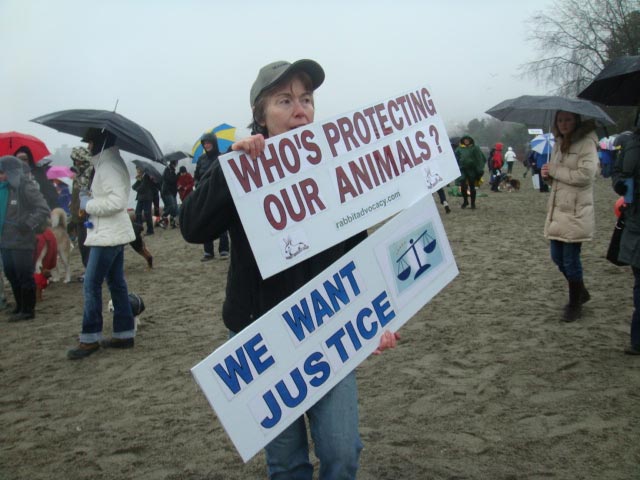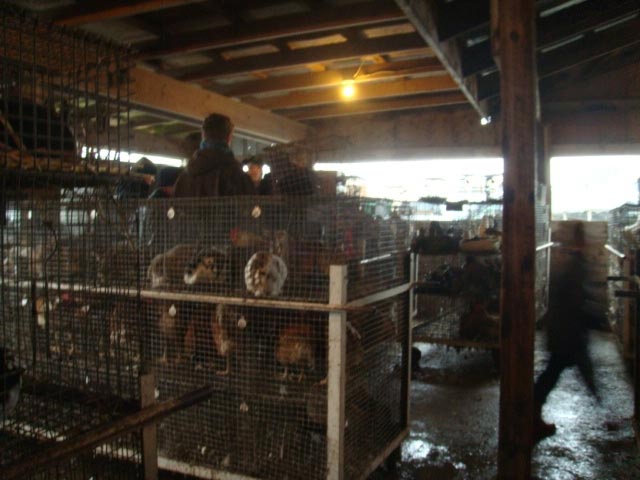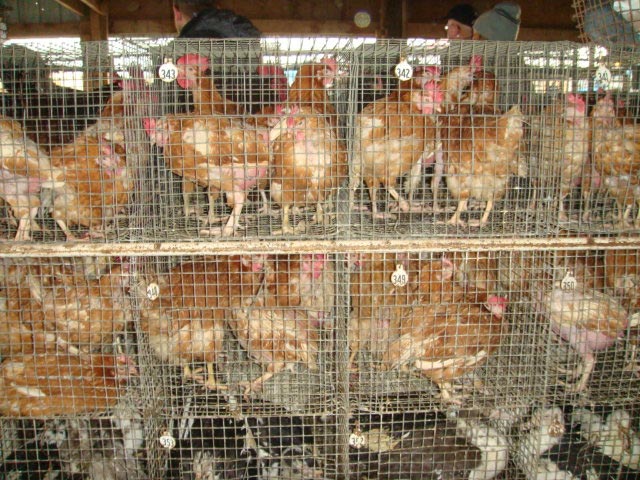Opinion: In the time it takes to read this, nearly 20,000 farm animals will be slaughtered
February 3, 2011 Stephen Hume, Vancouver Sun
Public outrage at the expedient slaughter of 100 inconvenient sled dogs is entirely appropriate and you don't have to be dog lover or an ethics professor to know why. Breeding dogs for a life in which gruelling work in harness is the only respite from a miserable existence at the end of a two-metre chain and then exterminating them when business falls off is just plain wrong.
There's another question we should be asking, however. Why do we rise up in collective wrath over something like the appalling incident in Whistler while shrugging off the inhumane and unethical treatment of so many other animals?
Right now we're upset over the massacre of sled dogs. But by the time you've finished reading this short column, close to 20,000 farm animals will have been slaughtered nationwide, according to Canadian Meat Council statistics.
An hour from now, the number of animals killed will be over 75,000. By the end of the day it will be more than 1.8 million. By the end of the week, 12.5 million animals will have been slaughtered. By next February, at least 650 million animals will have been sacrificed to our wants. Troubling numbers live in close confinement under conditions so dreadful they go insane.
As No Country for Animals, a documentary by Global Television, discovered last September, animals in Canada are largely without effective protection from cruelty, abuse and neglect. Global revealed live poultry being tossed around by workers like sacks, pigs in cages scarcely larger than their bodies, calves awaiting slaughter with horrendous wounds, dogs caged in puppy mills that one investigator described as "canine hell." You can view Global's documentary online or get Slaughterhouse, by Gail A. Eisnitz, from the library.
In researching her book, Humane Farming Association investigator Eisnitz learned to her horror that hogs and poultry are often alive when scalded to remove bristles and feathers. And that cattle, horses and sheep were sometimes skinned alive. Small wonder that slaughterhouse workers told her that terrified animals in the production line would sometimes die of heart attacks before they got to the killing floor.
You can visit some of the websites of organizations taking up the cause for the humane treatment of farm animals, like Canadians for the Ethical Treatment of Food Animals which is presently concerned with the conditions under which animals are transported.
I find it curious that we're justifiably disturbed by the unspeakable act at Whistler yet remain largely complacent about the cruel and completely unnecessary slaughter of other animals. For example, hundreds of grizzly bears are killed in an annual trophy shoot for which the preferred euphemism is "harvest." Perhaps it's because a mass event is more troubling than a whole series of events scattered over time and landscape. Yet the suffering of the animals are not collective, they are individual.
Shooting a hundred dogs at once may have been traumatizing to the shooter and was certainly traumatizing to the victims but it still represented 100 individual moments of terror and pain. If the usual 250 grizzlies are shot this year in the trophy hunt, the individual trauma increases correspondingly. Hunters like to argue that bears die painlessly. No, they don't.
Anybody who thinks that killing a 300-kilogram animal with a high-powered rifle intended to smash bone and shred internal organs is more humane than shooting those dogs at Whistler is in deep denial or has no idea what's involved.
A few years ago, when activists sought to air an anti-hunting ad which featured a clip of a bear writhing in agony after being shot in the spine while hunters laughed at the sight, it was considered too traumatic for public consumption.
Let's be clear, something resembling the suffering at Whistler happens almost every time some trophy hunter puts a high-velocity bullet into a grizzly bear. Hunters sufficiently skilled to kill a bear instantly with a single shot are few and far between. To make it worse, trophy grizzlies are killed for fun, not because they pose a threat to anyone; not because there's a need for their pelts or their meat.
In a way, that makes the annual grizzly slaughter even worse than the killing of the sled dogs at Whistler, for which the company at least had the excuse that it couldn't afford to feed them. What's the justification for inflicting pain and suffering on animals for pleasure?
Comment: The massacre of the Whistler sled dogs has generated widespread news coverage and global outrage. The RCMP and the BC SPCA are investigating Howling Dog Tours and Outdoor Adventures Whistler. (the dogs were reported to the SPCA a number of times over the years, as were other sled dogs) These animals were killed after the Olympics last year when tourism fell. Used as money-making commodities. Destroyed for economic reasons, although the denials are starting. The BC government has appointed a task force and it has been given 45 days to conduct an investigation and make recommendations. They will be made public upon completion. It’s been said that when a task force is set up the cover-ups begin.
People
want justice and are asking why WorkSafe BC approved the slaughterer’s
claim of post-traumatic stress disorder and why it wasn’t reported to the
authorities. What about the dogs who were murdered in cold blood of each other.
Susie had the left side of her cheek blown off and her eyeball hanging out of
its socket when Fawcett accidentally dropped the leash and she was able to run
off. He had to chase her down and shoot her using a scope on the firearm.
Then there was Nora, who the manager noticed crawling
among the 10 or more dead dogs about 20 minutes after he shot her outside the
company's compound and buried in a mass grave. He had to climb down into the pit
to "put her out of her misery."
The
Animal Legal Defense Fund (ALDF;
http://www.aldf.org) is
offering a $1,000 US reward for information leading to the arrest and conviction
of anyone engaged in the illegal killing of sled dogs in the U.S. or Canada.
The Barking Mad demonstration at Ambleside was one of several in B.C. The
unfolding news and blame carries on.
He had to climb down into the pit
to "put her out of her misery."
The
Animal Legal Defense Fund (ALDF;
http://www.aldf.org) is
offering a $1,000 US reward for information leading to the arrest and conviction
of anyone engaged in the illegal killing of sled dogs in the U.S. or Canada.
The Barking Mad demonstration at Ambleside was one of several in B.C. The
unfolding news and blame carries on.
April 5/11 Update B.C. will bring in tough new animal cruelty laws — including $75,000 fines and two-year jail terms — following the alleged slaughter of 100 dogs by a Whistler company last spring, Premier Christy Clark announced this morning. Sled Dog Task Force
December 3, 2016 Sled Dogs, a Canadian documentary film, is the first to reveal the shocking cruelty by the dogsledding industry.
Remembering the other animals that suffer CKNW February 3, 2011
As Stephen Hume points out in the Vancouver Sun, in the time it takes to read an article, 20,000 animals are slaughtered for food. And because of lax laws in Canada, many of them die inhumanely. Pigs, horses and goats are sometimes scalded or skinned alive. Cows regularly die of heart attacks before they reach the killing floor…slaughterhouse workers believe they die of terror. While mass vegetarianism isn’t the answer, perhaps we need to know more…and then demand stronger laws for the animals whose deaths give us life.
Gail Eisnitz, author
of Slaughterhouse is Bill Good’s guest. The inhumanity of our species is so
disgusting, there are no words strong enough to depict our deplorable attitudes
and behaviour toward other species. Animals are living, feeling beings just like
us, yet we feel we’re entitled to use and abuse them at will. And we do. They
suffer and die on a massive scale and are treated like trash. And yet we call
ourselves superior or humanitarians – the unmitigated gall. Carmina Gooch’s
note to the station (in email below) was read on-air, hopefully jarring some
listeners into at least thinking about their actions or lack thereof. 
Carmina Gooch’s letter of February 7, 2011 to provincial and federal politicians
Re: Fraser Valley Auctions, Farm Animals and Cruelty Legislation
Dear Officials:
In light of the recent coverage and outrage over the slaughter of 100 Whistler sled dogs, I am writing with regard to animal protection laws and the enforcement of cruelty regulations. Specifically, I am referring to farm animals.
Animals raised for food are by far the largest single group of animals exploited in BC and across Canada. Yet, they are offered virtually no protection under existing federal or provincial laws. Unbelievably, they are still regarded as property under the Criminal Code of Canada.
The economic interests of farmers are top priority, leaving both animal and to a lesser degree, the consumer of such ‘products’ unprotected. Livestock, whether they be pigs, chickens, cows or other institutionalized beings, are subjected to inhumane husbandry, transport, and slaughter standards. From the time they enter this world until the time their lives end, they are mistreated and regarded as mere commodities for human livelihood and utility. What may be construed as humane industry standards for non-human species would most definitely not apply to human beings. Why the difference?
Other countries, for example, have recognized the need for overhauling archaic legislation. Battery cages, veal crates, and sow stalls are in the process of being phased out in many North American jurisdictions and in Europe.
The Agricultural Ministries in Canada have or appear to have a stake in the ongoing exploitation of food animals, and this is troublesome indeed. Our prevention of cruelty laws are selective, with ‘owned’ animals being granted some protection, while most others are without.
By next February, at least 650 million animals will have been sacrificed to our wants. Troubling numbers live in close confinement under conditions so dreadful they go insane.
As No Country for Animals, a documentary by Global Television, discovered last September, animals in Canada are largely without effective protection from cruelty, abuse and neglect.
Global revealed live poultry being tossed around by workers like sacks, pigs in cages scarcely larger than their bodies, calves awaiting slaughter with horrendous wounds, dogs caged in puppy mills that one investigator described as "canine hell." You can view Global's documentary online or get Slaughterhouse, by Gail A. Eisnitz, from the library.
In researching her book, Humane Farming Association investigator Eisnitz learned to her horror that hogs and poultry are often alive when scalded to remove bristles and feathers. And that cattle, horses and sheep were sometimes skinned alive.
Small wonder that slaughterhouse workers told her that terrified animals in the production line would sometimes die of heart attacks before they got to the killing floor. (Source: Vancouver Sun, 02/03/11)
In recent correspondence with Gerry Ritz, Minister of Agriculture and Agri-Food, I was updated with the Canadian government’s efforts to ensure the safety and well-being of farm animals. However, increasing penalties for violations during transport does nothing to address the day-to-day suffering of the animals nor is it a proactive measure. It’s reactionary.
It was also widely reported in September 2010 that one quarter of animal mistreatment penalties go uncollected.
I am to understand that the Ministry is providing funding to develop national codes of practice, but as I’ve mentioned previously, there are no national codes to protect meat rabbits. The National Farm Animal Care Council (NFAAC) has said that no national group representing rabbits has come forward to represent the interests of these animals. Additionally, rabbits exported into the United States, are not offered protection under the Humane Slaughter Act.
Regardless of federal or provincial legislation of the farm industry, regulations need to be tightened and enforced. I have attended the Fraser Valley Auctions in Langley on several occasions lately and have been appalled at the number of injured, sick or dying animals I saw and documented. In 2008, the Lifeforce report, Selling Lives: Fraser Valley Auctions Investigation, gave graphic examples of abuses of the animals/ birds on site. Honourable Ritz assured me that “the CFIA has maintained a regular presence at the Fraser Valley Auctions of the past several years. The CFIA attends auctions in an oversight capacity and notifies the British Columbia SPCA when concerns are raised about how animals are handled in the pens or in the ring. Incidents related to loading, unloading or transport come under the Health of Animals Regulations.”
Remembering the other animals that suffer
February 3, 2011 CKNW
From Carmina - The past two weekends I attended the Fraser Valley Auctions in Langley and was appalled at the number of sick, injured and dying animals/birds I saw. In particular, an injured chicken couldn’t get up from her tiny cage. Another chicken tried to avoid stepping on her. Two different employees were made aware of it. One came over, opened the cage, picked her up under her wings, put her back down, and said there was nothing he could do about it. Another employee said that’s why they “go for so cheap.” We saw the buyers put her in a cardboard box, and when asked how the chicken was, the reply was that they thought it was nearly dead. Where’s the oversight? Why aren’t veterinarians or inspectors on hand?
The auctioneer frequently refers to animals as good money-makers, which is exactly how they are viewed, mere commodities. He also referred to rabbits as “good-looking fryers.” I strongly suggest that BC SPCA officers make a trip to this auction and see for themselves what is going on. From my view, there were a number of animal welfare and health violations. An inspection system is needed to monitor the condition of livestock that goes to auction in our province.
On November 23, 2010, the Ministry of Agriculture launched a 60-day review of the Animal Disease Control Act and related policies.
B.C. chief veterinary officer Paul Kitching said the province licenses animal auctions but does not have a system in place for inspections. He said that the review will help the province bring its legislation around disease prevention and control in line with the rest of the country. He further added the 50-year-old legislation is outdated and doesn’t address a range of diseases nor reflect the relationship between provincial and federal authorities. “There’s a whole spectrum of disease which aren’t mentioned, aren’t included, weren’t even identified possibly in those days.”
Animal welfare and animal rights are of concern to Canadians, and I am adding my voice to the many citizens of our country in asking for improved reforms to legislation that would protect animals and punish those who abuse and mistreat our valued animal friends, no matter how they are categorized.
In 2008, Canada was ranked last in an International Fund for Animal Welfare survey of animal cruelty laws in 14 countries. In June 2010, the Animal Legal Defense Fund (ALDF) released its Canadian Animal Protection Law Rankings, with B.C. in the middle tier.
All animals need protection, and laws throughout the country must be strengthened. The Rabbit Advocacy Group of BC has a PSA, Who’s protecting our animals? in tomorrow’s Vancouver Sun and on Wednesday, in The Province. (attached)
February 28, 2012 Codes of Practice fail to protect farm animals; NFACC Reports; Timelines & updates; NFAHWC; Maple Lodge inhumanity, misleads consumers, complaint filed; BC chicken farms sadistic cruelty 2017; Fraser Valley hens buried, trapped in feces 2018
Related: Undercover video by MFA reveals severe abuse of dairy cows at Chilliwack Cattle Sales
February 12, 2016 Puppy mill seizure illustrates need for proactive law enforcement; updates
Comment: Carmina Gooch contacted the BC SPCA about another recent case, wherein a Winlaw Valley man is facing a 4th animal cruelty charge after the organization seized an assortment of 29 animals, including sheep, dogs, and goats. Carcasses of horses and other large animals were also found. Clearly, the system in place to protect the vulnerable and voiceless has failed yet again. It was verified by a visit to the Nelson Court that the BC SPCA, the only animal welfare organization in BC with the authority to enforce laws relating to animal cruelty, had been informed of the ownership ban and the offender’s location.
We also contacted federal government politicians, including our MP, Terry Beech, regarding The chronic shortage of slaughterhouse workers in Canada. I couldn't believe the response from Beech which read: "Your message is the first that we have received on the issue of slaughterhouses and the role animals currently play in our economic output." Gooch’s letter February 05, 2016


